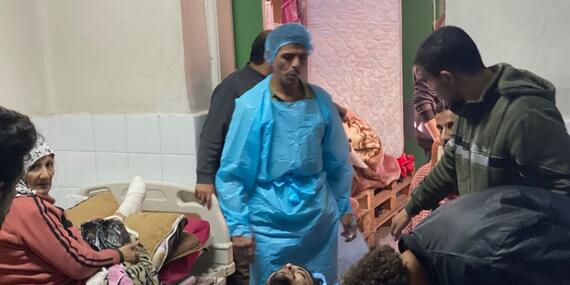Today's top news: Occupied Palestinian Territory, Sudan, Syria

Occupied Palestinian Territory
The Under-Secretary-General for Humanitarian Affairs, Martin Griffiths, has warned that Gaza is a public health disaster in the making, with infectious diseases spreading fast in overcrowded shelters. In a social media post, Mr. Griffiths said hospitals are barely functioning and unable to provide care to hundreds of people injured by the ongoing fighting.
As intense Israeli bombardments continue across most of the Gaza Strip, the World Health Organization reports that 21 of Gaza's 36 hospitals are no longer functioning. Of the 13 hospitals functioning only partially, nine are in the south. Those hospitals are operating at three times their capacity, while facing critical supply and fuel shortages. In the north, four hospitals are providing maternity, trauma and emergency care services, despite a lack of staff and medical supplies, as well as fuel, food and drinking water.
Meanwhile, only eight of 22 health centres run by the UN Relief and Works Agency for Palestine Refugees in the Near East (UNRWA) south of Wadi Gaza are still operating. Nearly 100 UNRWA medical teams continue to treat internally displaced people at shelters.
OCHA warns that the intensity of the fighting in Gaza continues to impede ongoing efforts to provide health care and other life-saving assistance to civilians. Insecurity, blocked roads, and fuel shortages also hamper humanitarian operations, as do frequent disruptions to telecommunications.
Sudan
OCHA warns that the spread of the conflict in Sudan is hampering efforts to reach civilians in need, including those newly displaced by fierce fighting in Aj Jazirah State earlier this month.
Over the past two weeks, as many as 300,000 people have fled areas in and around the state capital, Wad Medani. As they arrive in other states – including Gedaref, Kassala, Red Sea, Sennar and White Nile – and cross over the border into South Sudan, humanitarian organizations are working to provide assistance. However, there is an urgent need for additional resources, including shelter, food and other basic items, as available stocks are low and the ability to move supplies remains extremely challenging.
As of Tuesday, some 4,000 people displaced from Wad Medani reportedly arrived in the Red Sea State capital of Port Sudan, with more people expected in the coming days. Nine new displacement sites, mostly schools, have been identified to host them.
In Gedaref State, an estimated 15,000 people have sought shelter with host communities. Humanitarian partners there are scaling up efforts to provide food, water, sanitation, hygiene and health support, as well as protection services, to displaced people as they arrive.
In Kassala State, some 3,000 people newly displaced from Aj Jazirah state have received food assistance from the World Food Programme.
Sudan is one of the world’s most challenging places for humanitarians to operate. Almost 25 million people are estimated to need humanitarian relief in 2024, the majority of them in conflict hotspots – including Khartoum, Darfur and Kordofan – which are increasingly difficult for aid agencies to reach.
Syria
OCHA remains concerned over the impact on civilians of ongoing hostilities in northwest and northeast Syria. Renewed fighting in northern Syria since late August has been the most significant since 2019, resulting in hundreds of civilian casualties and the displacement of tens of thousands of people.
On Monday, 25 December, shelling and airstrikes hit residential areas in Idleb and western Aleppo in northwest Syria, killing at least six people, including a mother, father and their three children. Six other civilians were injured, according to local health authorities, including three children residing in a temporary shelter inside a school. A primary health center in Sarmin, which took in civilians wounded by the hostilities, also sustained minor damage due to shelling.
On the same day, in northeast Syria, strikes hit several residential areas and civilian facilities in Qamishli City, Tell Refaat, Alin Al-Arab and other areas in Al Hasakah and Aleppo governorates. According to local sources, at least 12 civilians were killed. Strikes in Ain Al-Arab have reportedly damaged a health clinic, putting it out of service.
Health partners are warning of overstretched resources this winter, as cases of respiratory infections increase to the highest levels witnessed in northwest Syria in five years, with children under the age of five particularly affected. The UN and humanitarian partners continue to support civilians and local health facilities, but additional donor support is urgently needed. At the end of 2023, the annual Humanitarian Response Plan for Syria is just 36 per cent funded, with $2 billion received of the required $5.4 billion.
